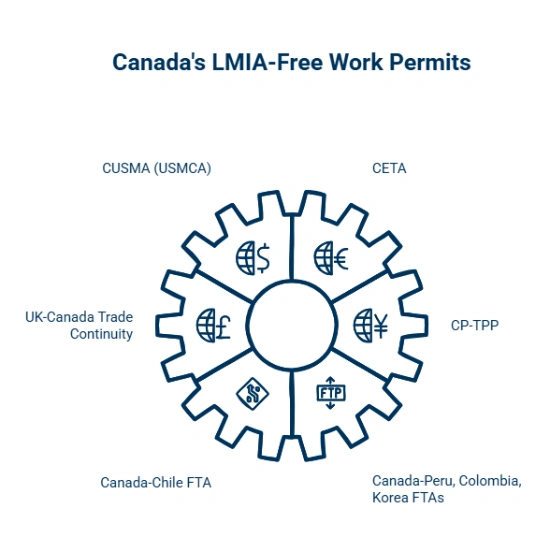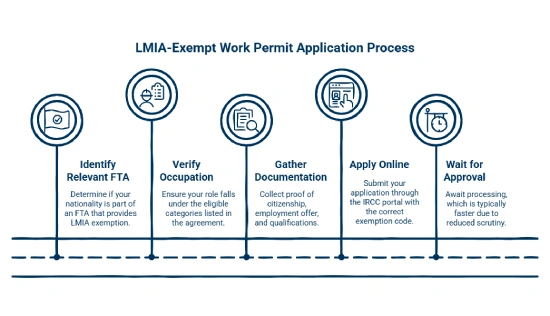Highlights: No LMIA Needed: Canada’s 2025 FTA Work Permits Simplify Global Hiring
- Citizens of over 40 countries can apply for LMIA-exempt work permits under Canada’s active FTAs.
- Major trade agreements include CETA, CPTPP, CUSMA, and FTAs with Chile, Colombia, Peru, and others.
- Eligible applicants include professionals, investors, intra-company transferees, and service suppliers.
- Businesses can transfer executives and skilled workers to Canadian offices more easily under these exemptions.
- The process reduces paperwork and accelerates entry for qualified foreign workers.
*Want to work in Canada? Let Y-Axis guide you with the process.
Work without an LMIA: Here Are the Countries Eligible in 2025
Canada continues to expand its global partnerships, making it easier for citizens of over 50 countries to work in Canada without requiring a Labour Market Impact Assessment (LMIA). Through its network of Free Trade Agreements (FTAs), such as CUSMA, CETA, and CPTPP, Canada offers LMIA-exempt work permits to foreign workers in select professional categories.
These exemptions streamline the hiring process for Canadian employers and create smoother pathways for international talent. Indian professionals, in particular, benefit through agreements like the Canada–India CEPA and others under GATS (General Agreement on Trade in Services).
Here’s a table summarizing the major Free Trade Agreement (FTA) and the participating countries whose citizens are eligible for LMIA-exempt work permits:
|
Country |
Applicable FTA(s) |
|
Australia |
CPTPP |
|
Austria |
CETA |
|
Belgium |
CETA |
|
Brunei |
CPTPP |
|
Bulgaria |
CETA |
|
Chile |
CPTPP, CCFTA |
|
Colombia |
CCOFTA |
|
Croatia |
CETA |
|
Cyprus |
CETA |
|
Czechia |
CETA |
|
Denmark |
CETA |
|
Estonia |
CETA |
|
Finland |
CETA |
|
France |
CETA |
|
Germany |
CETA |
|
Greece |
CETA |
|
Hungary |
CETA |
|
Ireland |
CETA |
|
Italy |
CETA |
|
Japan |
CPTPP |
|
Latvia |
CETA |
|
Lithuania |
CETA |
|
Luxembourg |
CETA |
|
Malaysia |
CPTPP |
|
Malta |
CETA |
|
Mexico |
CUSMA, CPTPP |
|
Netherlands |
CETA |
|
New Zealand |
CPTPP |
|
Peru |
CPTPP |
|
Poland |
CETA |
|
Portugal |
CETA |
|
Romania |
CETA |
|
Singapore |
CPTPP |
|
Slovakia |
CETA |
|
Slovenia |
CETA |
|
Spain |
CETA |
|
Sweden |
CETA |
|
United States |
CUSMA |
|
Vietnam |
CPTPP |
*Looking to work in Canada? Sign up with Y-Axis for end-to-end assistance with the procedure.
Fast-Track to Canada: LMIA-Free Work Permits under Key International Agreements
Canada's Free Trade Agreements open doors for professionals, business people, and transferees from partner countries to work without needing an LMIA.

Here's a quick overview of the main agreements, eligible applicants, and how long their permits are valid:
|
Agreement |
Eligible Applicants |
Validity |
|
CUSMA (USMCA) – U.S., Mexico |
Professionals, Intra-company transferees, Traders & Investors |
Up to 3 years (renewable) |
|
CETA – EU countries |
Business visitors, Investors, Intra-company transferees, Professionals |
1–3 years (varies by category) |
|
UK-Canada Trade Continuity |
Professionals and business visitors |
Up to 1 year (renewable) |
|
CP-TPP – 10 Pacific countries |
Business visitors, Investors, Professionals |
Typically 1 year (renewable) |
|
Canada-Chile FTA |
Professionals and intra-company transferees |
Up to 1 year (renewable) |
|
Canada-Peru, Colombia, Korea FTAs |
Similar categories as above |
1–2 years (based on FTA) |
*Looking for jobs in Canada? Avail Y-Axis Job Search Services to find the right one.
How to Apply: Steps to Secure Your LMIA-Exempt Work Permit
Applying for an LMIA-exempt work permit under a Free Trade Agreement is relatively streamlined, but applicants must meet specific eligibility criteria. Whether you are a professional, business visitor, or intra-company transferee, the right documentation and process can make all the difference.
Here is what applicants need to do:
Step 1: Identify the relevant FTA: Ensure your nationality is part of an FTA that provides LMIA exemption.
Step 2: Verify your occupation: The role must fall under the eligible categories listed in the respective agreement.
Step 3: Gather documentation: This includes proof of citizenship, employment offer from a Canadian employer, and qualifications for the role.
Step 4: Apply online: Submit your application through the IRCC portal with the correct exemption code and pay the applicable fees.
Step 5: Wait for approval: Processing times may vary, but applications under these programs typically move faster due to reduced scrutiny.
Note: This simplified pathway not only supports skilled professionals from partner countries but also helps Canadian employers tap into global talent quickly and efficiently.

*Are you looking for step-by-step assistance with Canadian immigration? Contact Y-Axis, the world’s No. 1 overseas immigration consultancy!
For recent immigration updates on Canada, check out Y-Axis Canada Immigration News Page!
